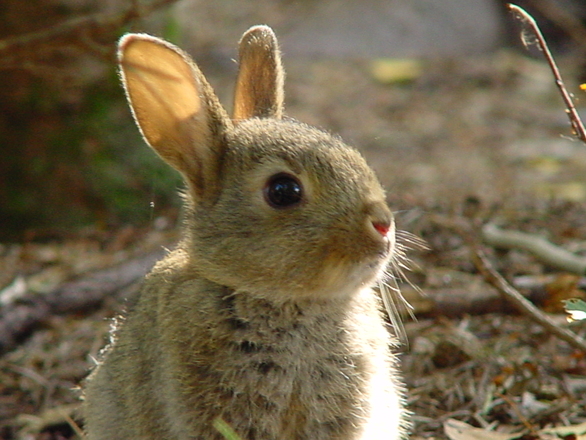Christianity, in many ways, originates with Easter: Jesus Christ’s resurrection from the dead is a cornerstone of the faith. The Easter Bunny, most maintain, originates in German folklore involving a rabbit that delivered colored eggs to good little girls and boys. And the holiday’s bunnies, chicks, and eggs, of course, have longed served as symbols of fertility, rebirth, and new life. But what about the word rabbit?
Down the rabbit hole
Some of my favorite etymologies concern those simple, everyday words whose origins we simply don’t know. Over at Oxford Dictionaries, I recently wrote about a number of them, including dog. Yes, dog; we just don’t know what, er, etymological tree it’s barking up. We can add to this list rabbit, another commonplace word for a commonplace animal whose origins are obscure.
Here’s the problem with rabbit: there is apparently no native Celtic or Germanic word for this animal, as the critter was not native to northern Europe. These early cultures had a word for hare, no doubt, but not the rabbit. Now, I can’t quite tell you the difference between the rabbit and the hare, but the lexicon of our Indo-European ancestors certainly registered them.

We have record of rabbit by the late 14th century. Origins have been proposed like, well, rabbits. But, in his excellent An Analytic Dictionary of English Etymology, professor and philologist Anatoly Liberman easily dispatches with many of the early ones, including: the Hebrew for “copulate,” the same Latin root that yields rabies, the Greek for “creeper,” and even the name Robert.
But the picture gets more complicated when we consider robett, the word for rabbit in Walloon, a Romance language spoken in parts of Belgium and France (and, for a time, in Wisconsin). This cognate, though now considered borrowed from Flemish, has led many etymologists to seek a Romance root for rabbit, including in the French râble (“back and loin of the rabbit”) and the Spanish rabo (“tail”). Liberman traps these hypotheses, as tempting as they may look.
Instead, Liberman looks to a structure used in Germanic animal names, including German’s Robbe (“seal”) and the Icelandic robbi (“sheep, ram”): r + vowel + b. He also roots robin, whose name has been of equally problematic origin, in this structure. Onto this base was added a French suffix along the lines of -et or –ot.
As Liberman nicely sums it up: “Rabbit is a Germanic noun with a French suffix.”
But what does r-b mean? Speakers of ancient Germanic languages apparently – and arbitrarily – had this sound complex available as vehicle for naming animals of all sizes and stripes. And the French -et or -ot signifies diminutives. So, a rabbit, if Liberman is correct, is some sort of little animal-type thingy.
Liberman puts rabbit into the bigger picture for us: “Rabbits were well known in the British Isles by the year 1200, but the word rabbit surfaced two centuries later. Most likely, speakers of English coined many words for the new animal. They are all lost, while rabbit has survived. The sound complex r-b in the name of the rabbit has no parallels outside Germanic.”

In the rabbit warren
English does have other words in its leporine lexicon, though. Coney was an earlier name for “rabbit,” attested by the early 13th century though largely displaced by the 19th century; its historic pronunciation, rhyming with honey, yielded some coarse slang. Coney ultimately derives from the French conil, which, in turn, comes from the Latin cunīculus.
But, like English’s own rabbit, cunīculus was not a native term for the Romans. Historians, even ancient historians, note that Spaniards introduced rabbits to the Romans. In Spanish, rabbit is conejo, though this develops from the Latin; etymologists suggest an ultimately Iberian origin for the word.
Some claim, though it’s disputed, the very name Spain means “land of rabbits,” from a Phoenician root for the “hyrax,” cognate, from what I gather, to Hebrew’s šāpān. The King James Bible uses coney, in fact, to translate the name for this creature that looks like a rodent but is not related.

The rock hyrax, actually related to elephants, not rabbits. Image from http://www.freeimages.com/photographer/revi82-62142.
Bunny hops onto the scene last. The OED cites it as a “pet name for a rabbit” by 1606, from bun. Documented a few decades earlier, bun originally named a “squirrel” or a “rabbit,” leading some to a Scottish word referring to “tail.” But the ultimate origin is unknown – which, for an etymology nerd like me, is like candy in my Easter basket. Just no Peeps, please.
Wait! I read a book by Peter Trudgill entitled [Sociolinguistic: An Introduction] last week, and I found out why the word coney can’t be used to appoint the first picture of animal above. Rabbit hops and it is everywhere in my mind 😀
LikeLiked by 1 person
Thank you. I see a rabbit never escaped your eye or pen. I snared them on bunny trails where they went through woven wire fences as a kid. Rabbit stew sustained us some cold winter days..
LikeLike
Wikipedia under its page for Spanish words of Basque origin goes along with a Proto-Basque *(H)unči (modern Basque untxi) as a possible etymology for Latin cuniculus (Spanish conejo; Portuguese coelho) for “rabbit” but also mentions an alternative possibility of a Hispano-Celtic *cun-icos ‘little dog’.
LikeLike
Thanks for passing that along! I did see some Basque suggestions in my research. I think it’s absolutely fascinating that such an everyday word like “rabbit” would come from a Basque root.
LikeLike
It’s not fascinating that it comes from Spanish roots (Isn’t that was Basque is?) when your daughter’s a Veterinarian’s Technician. I think that Spain and Italy are where, according to her, the rabbit originated. People took it out of its environment, like humans decide to do w/ MOST animals, and brought the animal with them when they traveled back to their native lands in northern Europe and then took w/ them when they crossed the Atlantic to America. I don’t recall everything she said about it, I just know that yet again animals were displaced by humans and then complained about proliferating too much (by the same people who created the issue) and decided upon killing them to “control the problem.” People don’t seem so clever to me, if killing another living thing is their FIRST idea for “controlling the exploding population of rabbits, or cats,” or whatever else they think is giving them a problem.
I may be a hypersensitive vegetarian but I’m tired of that response being the first, as opposed to last, solution they reach for and then try to claim vast ‘superiority’ of humans over animals.
Rabbits populate so much because they fall into the category of prey animal and almost everything preys on them so like rats they HAVE to reproduce in sheer numbers to survive all the predators and continue their species. Until I talked to my daughter I had no idea animals fell into one of two categories: prey or predator and that the ones that are prey have a major characteristic in common with all other prey. Their eyes are on the sides of their heads instead of in front like humans, dogs & wolves. Their eyes are on the side so they can see prey coming before it arrives and get down their holes.
Also, they’re not ‘scared rabbits’ down their hole. If an invader puts its hand or paw (or snout) down a rabbit hole, it’ll be attacked by the rabbit. That’s why if a rabbit’s in a cage and you stick your hand in the bunny will start trying to ‘protect it’s hole’ and try to bit your hand off. My daughter’s bunny did that when I was trying to get her out of her cage. She started thumping her hind legs and acting all angry, then snapped at me. I couldn’t get her out w/out being bitten so I stopped trying. Then I learned that they view their cages as their rabbit hole.
LikeLike
Yes, Spanish roots, especially when they are not Latin (e.g., Basque, Arabic) are always fascinating.
LikeLike
The hyrax is called šāfān in Hebrew, but this word is significantly conflated with the meaning of ‘rabbit’. It is actually the word used in the expression “pull a rabbit out of a hat”. This usage apparently stems from misinterpretation by European scholars unfamiliar with the hyrax or Arabic cognates of this word.
The Hebrew word for island is i (ee). I’ve heard the suggestion of hispania originating in phoenician for ‘island of rabbits’, but to my limited understanding of these languages the plural in “i šfānayyâ” would fit aramaic and not phoenician. However, I’m not sure šāfān is used in aramaic as I’ve seen it be translated into another word.
LikeLike
I, too, have had the ‘island of rabbits’ origin for ‘Spain’ from a Semitic or Arabic, though others have suggested something Celto-Iberian.
LikeLike